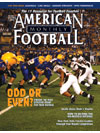AMERICAN FOOTBALL MONTHLY THE #1 RESOURCE FOR FOOTBALL COACHES
Article CategoriesAFM Magazine
|
Letter From the Editor/Publisher: Being an Effective Linebackerby: Rex LardnerEditor American Football Monthly © More from this issue Chris Tormey is the linebackers coach and recruiting coordinator at the University of Washington. Having been a position coach, defensive coordinator and head coach, Tormey has learned from his mentors: Don James, Dennis Erickson, and Tyrone Willingham. With more than a quarter century devoted to coaching and especially linebackers, Tormey has formulated his own thoughts on a linebackers progress for success. He calls it: C.A.S.K.R.E.P.T. 1. “Communicate: It is the linebacker’s responsibility to communicate the defensive call, the strength call for alignment, the offensive formation, alignment of offensive personnel, and any motion or shift adjustments.” 2. “Alignment: The effective linebacker should know what his primary threats are based on formation tendencies and the defense called.” 3....The full article can only be seen by subscribers. Subscribe today!
|
|
|||||||
| HOME |
MAGAZINE |
SUBSCRIBE | ONLINE COLUMNISTS | COACHING VIDEOS |
Copyright 2025, AmericanFootballMonthly.com
All Rights Reserved





